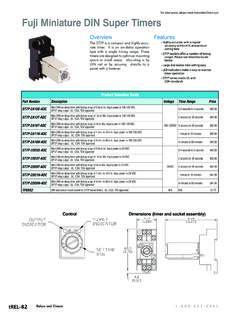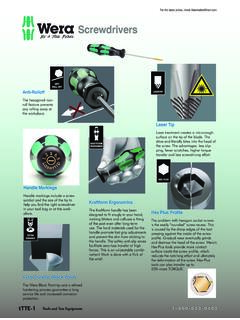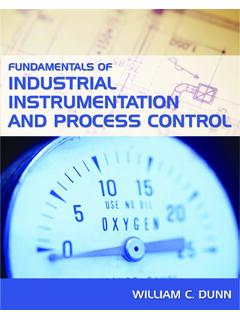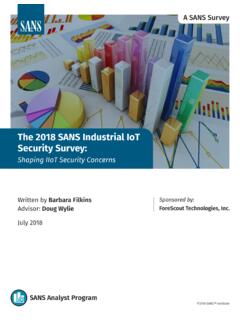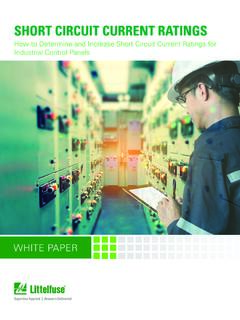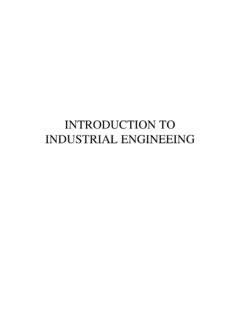Transcription of Automation 101: An Industry Guide To Control System ...
1 Automation 101: An Industry Guide To Control System Engineering A Condensed Guide to Automation Control System Specification, Design and Installation A Publication of Version TABLE OF. CONTENTS. Introduction Chapter 1 ------------ Consider Safety First Chapter 2 ------------ Identifying Processes for Automation Chapter 3 ------------ Specify Devices Chapter 4 ------------ Design Chapter 5 ------------ Build Chapter 6 ------------ Install and Start-up Chapter 7 ------------ Maintain Additional Resources f t in 2. Introduction The following is a general Guide to the specification, design and installation of automated Control systems. The information and references are presented in a logical order that will take you from the skills required to recognize an operation or process that may be suited for automating, to tips on setting up a program to maintain the Control System . Whether an expert or a novice at electrical Control devices and systems, the information presented should give you a check list to use in the steps to implementing an automated Control System .
2 The engineer's first problem in any design situation is to discover what the . problem really is. - Unknown f t in 3. CHAPTER. 1. Consider Safety First 4. Safety 4 Things to Consider The first most important item to consider before attempting an automated Control System , or even a simple on/off Control for a pump, is safety, both for personnel that may be working with or near the automated equipment, as well as to prevent damage to the equipment. To minimize the risk of potential safety problems, you should follow all applicable local, state and national codes that regulate the installation and operation of your Control System , along with the equipment or process it is designed to Control . These codes vary by area and usually change over time, constantly being reviewed and updated. It will be your responsibility to determine which codes should be followed and to verify that the equipment, installation, and operation is in compliance with the latest revision of these codes.
3 It would be wise to educate yourself as much as possible about electricity and electrical equipment in general. A good understanding of basic electricity, including DC and AC theory and practice, Ohm's Law, etc. will go a long way in helping you understand the various codes and standards. Want to learn some basic principles of electricity? We cover the basics of DC and AC theory, Ohm's Law, Kirchoff's Laws, and more in our blog post entitled Basic Electrical Theory . Visit to read more! f t in 5. 1. Avoid Endangering Your Personnel Most likely your Control System will be dealing with electrical energy, so your first goal will be to eliminate the risk of fire and electrical shock to personnel. At a minimum, you should follow all applicable sections of these two organizations. National Fire Protection Association (NFPA) fire code National Electrical Manufacturer's Association (NEMA). Some pertinent sections are: o ICS 1: General Standards for Industrial Control and Systems o ICS 3: Industrial Systems o ICS 6: Enclosures for Industrial Control Systems Please keep in mind that if the automated Control System you are developing needs to be accepted in the international market, the National Electrical Code (NEC), as a publication of NFPA, is being harmonized with the International Electrotechnical Commission (IEC) (Website: ).
4 And the European Hazardous Location Ratings. For more information, check the Instrument Society of America's (ISA) Website at Additional resources on the subject can be found at f t in 6. 2. Lockout/Tagout Another area of safety that needs to be considered for automated Control systems is lockout/tagout procedures as specified by Occupational Safety and Health Administration (OSHA). "Lockout/tagout" refers to specific practices and procedures to safeguard operators and maintenance personnel from the unexpected energization or startup of machinery and equipment, or the release of hazardous energy during service or maintenance activities. In order to have your Control System make use of a lockout/tagout procedure, the design should include the ability to shut off, neutralize, or isolate any energy source, such as the main electrical feed, but also any pneumatic, hydraulic or mechanical energy storage device.
5 The means to do this should be considered in the initial design of the automated Control System . Additional information can be found on OSHA's Website. 3. Avoiding Device Failures There are many reasons why the electrical devices that you will use in the design of your automated Control System should be listed, approved or registered with a testing laboratory. One reason is to ensure that the device meets standards that will prevent failure that could cause catastrophic results. Another reason might be for insurance or compliance purposes. One of the most specified and premier safety testing laboratories is Underwriters Laboratories (UL). The most applicable area of interest for Control systems is UL's Standard for Safety 508A. If your Control System panel requires being built to UL508A, then you will need to contract directly with UL to become a UL508A panel builder or use an existing UL508A panel builder.
6 Compliance to UL508A for products can be found on our Website at f t in 7. 4. Other Safety Considerations Emergency Stop The Control System must provide a quick manual method of disconnecting all System power to the machinery, equipment or process. The disconnect device or switch must be clearly labeled Emergency Stop . Accidental Powering of Outputs - Do not rely on the Automation Control System alone to provide a safe operating environment. You should use external electromechanical devices, such as relays or limit switches that are independent of any electronic controlling device, such as a solid state relay or a PLC (Programmable Logic Controller) output module, to provide protection for any part of the System that may cause personal injury or damage. These devices should be installed in a manner that prevents any machine operations from occurring unexpectedly. Ex. If the machine has a jammed part, the controlling System or PLC program can turn off the motor rotating a saw blade.
7 However, since the operator must open a guard to remove the part, you should also include a bypass switch that disconnects all System power any time the guard is opened. External safety devices such as light curtains, magnetic safety switches and safety relays can be integrated into your System design. Orderly Equipment Shutdown Whether using a Control System designed around relays and timers or a PLC, an orderly System shutdown sequence should be included in your design. If a fault is detected, then any mechanical motion, valve position, etc., needs to be returned to its fail-safe position and the equipment/process stopped. Grounding To prevent electrical shock, incorporate good grounding practices in the design, construction and installation of your System . Use protective devices for faulted conductors to prevent fire, and also realize that good grounding practices can reduce electromagnetic and radiated noise interference to sensitive electronic devices.
8 F t in 8. Control Power Distribution Develop a power distribution scheme in the Control System circuitry, according to code, that ensures all circuits are protected with fusing, circuit breakers or other interrupting means coordinated such that only the faulted circuit will be opened (de- energized), allowing other powered equipment and devices to continue to operate. Unauthorized Access Make sure all enclosures and cabinets that have energized circuits are secured to prevent unauthorized personnel from gaining access without the proper tool, key or other authorized means. Mechanical trapped key systems can be used to protect access to one or more physical locations of equipment in a Control System . Finger-Safe Another safety area to consider is the use of devices that have finger-safe terminal connections, which are surrounded by insulated guarding. The use of protective guards over live circuits should also be considered, even on Control panels that have limited access, so it is safer for maintenance electricians and authorized personnel to troubleshoot or make adjustments to electrical Control devices.
9 Dead Fronts Dead fronts should be used on Control System enclosures where the operator needs to make adjustments to devices, such as selector switches, thumbwheels, potentiometers, etc., and the controls need to be inside the enclosure so as to protect them from outside weather conditions. The dead front is normally an interior door that is mounted in front of the main Control panel. The outside enclosure door may still require key entry by the operator, but the dead front interior door with adjustable devices is interlocked so that it requires a switch to open it, disconnecting power to the electrical devices mounted on the main Control panel. Closed-loop Control It is your responsibility in any type of closed- loop Control System to ensure that if the feedback signal is lost, the System shuts down so as not to cause injury to personnel or damage to the equipment. f t in 9. CHAPTER. 2. Identifying Processes for Automation 10.
10 Identifying Processes for Automation After considering safety, the next step in configuring an automated Control System is to identify what can be automated. It will help if you have an understanding of basic hydraulics, pneumatics, mechanical operating mechanisms, electronics, Control sequences, etc. and a solid knowledge of the operation or process that you are going to automate. You should understand how to Control motion and movement, regulate the flow of fluids, dispense granular materials, orient parts, sense product in position, detect when an operation is complete, etc. As an example Let's say we have a conveyor that moves our product from point A to point B. The conveyor is powered by a 3-phase AC motor, which is turned off and on by a manually controlled motor starter and includes, for fire protection, both short circuit and overload protection. The System requires an operator to stand at the motor starter, watching as the product reaches the entrance to the conveyor, and turning the conveyor on to move the product.
